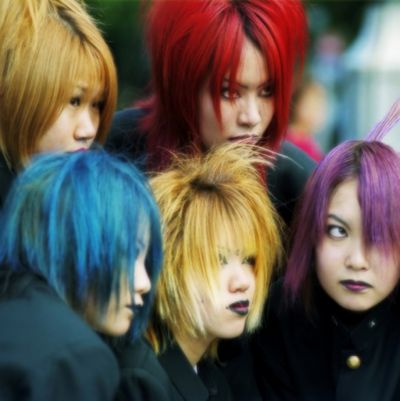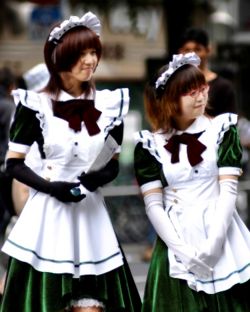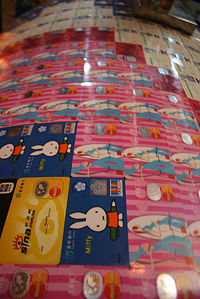Japanese popular culture

Photo © by Sonny Santos, used by permission.
Japanese popular culture is a highly distinct collection of fashions, art, music and other forms of expression, appearing in both mainstream society and underground subcultures. While some examples of these are widely known in the West, such as cinema's Godzilla monster, many today are either unique to Japan or mainly influence contemporary Asian popular culture.
Popular culture in Japan is very much the mainstream; while ancient sites are easy to find, the Japanese are rarely seen practising traditional arts such as ikebana (活花, 'flower arranging'). Cartoons, comics and above all, anything kawaii (可愛い, 'cute') are strong influences on high-tech products and clothes available in the high street, as well as teenage and children's fashions. While young Japanese often follow overseas trends, they have also developed their own trendy subcultures that to outsiders may border on the bizarre - young people dressed in maid outfits or in cute Victorian-style 'Lolita' costumes are more common a sight in Tokyo than traditionally-dressed maiko (妓) girls in historic Kyoto. These trends come and go, reported by the huge media industry, and also find a home in the more seedy areas of Japanese society. Template:TOC-right
Cuteness
Much of mainstream Japanese society conforms to the idea that goods and lifestyle choices should be kawaii (可愛い, 'cute'). Baby-faced cartoons such as Pokémon (ポケットモンスター, Poketto Monsutaa 'Pocket Monster') and small gadgets, often pink, are perhaps the best examples of this phenomenon, which is thought to be rooted in the rise of a Japanese consumer society in the 1970s, and also through the encouragement of dependent social relationships and the need to escape a highly stratified society.[1] Many adults adore cuteness as much as children and teenagers: for example, bank cards are available with cute cartoon characters printed on them, and though the culture of kawaii is most firmly established among young girls, grown men are prepared to be seen with cute items too. The prevalence of kawaii has led to criticism both within and outside Japan, depicting its society as one of increasing infantilisation; such goods tend to be popular with non-Japanese children but have yet to make inroads among foreign adults.[2] To a greater or lesser extent, each of the themes discussed below involves an appreciation of cuteness in some way.
Media
Japan is a nation of avid newspaper and magazine readers. About 92% of households subscribe to a morning newspaper, and the Japanese apparently consider print media to be the most reliable way to get their news. Newspaper circulation, with about 630 people to every thousand copies in the country, is significantly ahead of other nations,[3] including the USA[4] and the UK. News reporting ranges from serious political stories to the latest celebrity gossip, with the lives of these 'idols' detailed in popular magazines as well as on-line. Newspapers and the government often make use of comics (manga, 漫画 'comic') to put across important issues to people of all ages.[5] The biggest-selling newspapers are the right-wing Yomiuri Shimbun and the left-leaning Asahi Shimbun,[6] while one of most widely read magazines is FRUiTS, a guide to street fashion.[7]
'Idols'
Manga
Doraemon
Film, television and video games
Television
Video games
Pokémon
Technology
Internet
(blogosphere; Mixi)
Virtual characters
Robots
Purikura
Going out

Photo © by Sonny Santos, used by permission.
'Water trade'
Hostess bars
Karaoke
karaoke (カラオケ, 'empty orchestra')
Pachinko
Theme parks
Fashion and subcultures

Photo © by Sonny Santos, used by permission.
Office workers
Cosplayers
Otaku
Crazes
Relationships
Love hotels
Gay Japan
Sex industry
Soaplands
Enjo kousai
Footnotes
- ↑ Garger (2007).
- ↑ e.g. Kerr (2002:312).
- ↑ Yomiuri Shimbun (2008): 'Japanese newspapers have stable readership'.
- ↑ In the USA, readers have moved to online news sources over print media in recent years. See USA Today: 'Newspaper circulation off 2.6%; some count Web readers'. 5th November 2007. This was also true in the 1950s: see Time: 'Record Press Run'. 21st May 1956.
- ↑ For a controversial example of the use of manga to explain defence policy, see Mainichi Daily News: 'Defense Ministry turns to 'Lolita' manga character to reveal inner self'. 24th July 2007.
- ↑ See Yomiuri Shimbun (2008), above.
- ↑ STREET/FRUiTS/TUNE - official English website.
